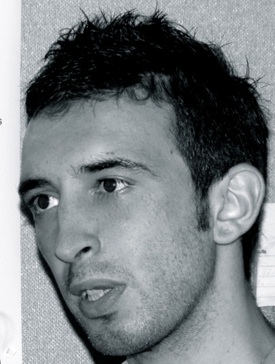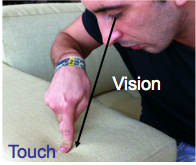Welcome to my personal page

M. Sc. Cristiano Cellini
Justus-Liebig-Universitaet Giessen
Fachbereich 06, Psychologie und Sportwissenschaft
Abteilung Allgemeine Psychologie
Otto-Behaghel-Strasse 10F
35394 Giessen
Campus: Building F1, Room 306
Phone: +49(0)641 / 99-26106
Fax: +49(0)641 / 99-26119

Since I was a child I had a big passion for the scientific subjects. My first interest was the neural plasticity and reinnervation. Later on I had the possibility to know autistic children, and from there, the interest to understand the neural basis of the Autistic Spectrum Disorder (ASD). Working with the reclaim of these function, where the perception of the world is strongly distorted, I understood that for me was more important to investigate how the human being perceive the world. I moved then into the world of visual perception. During my master thesis and I had the opportunity to had a research experience abroad, precisely in the Prof. Bernard Hommel lab´s in Leiden, Netherlands, where I worked on two different projects: 1) Binding problem and theory of event code. 2) Inhibition of response using the Local-Global task with and without acoustic noise.
Currently I am working in the Prof. Karl Gegenfurtner lab´s in Giessen, Germany The research project deals with the integration of information from different sources. The estimate of an environmental property by a sensory system can be represented as the operation by which the nervous system does the estimation. This operation could refer to different modalities (vision, touch) or could also refer to different cues within a modality.
Visuo-Haptic Cross modal integration
One of my projects focuses on the cross-modal integration of objects properties. I am interested in the visual and haptic integration in the estimation of softness. Participants were able to distinguish softness haptically alone and even visually alone. In visuo-haptic conditions, information from the two senses seems to have been integrated into combined softness estimates. Importantly, observed visual weights were higher than we had predicted from optimal integration. Moreover, observed visual weights were similar for the hard and the soft stimuli, whereas optimal visual weights had been predicted to be larger for the soft as compared to the hard range. Correspondingly, visuo-haptic softness discrimination was worse than predicted, at least for the hard stimuli. Taken together, these results argue against an optimal integration of direct haptic with indirect visual information. It even seems as if vision is given a fixed weight independent of visual reliability.
Another focus of my research deals with cue integration within modality.
Haptic Flash Lag Effect
I focused my research on the investigation of a haptic Flash-lag Effect. The flash-lag effect is a visual illusion wherein a flash and a moving object that appear in the same location are perceived to be displaced from one another. Several explanations for this simple illusion have been explored in the neuroscience literature: motion extrapolation, latency difference and motion integration and postdiction. Our results show that the flash-lag effect is also present in the haptic modality and that the effect increases with the velocity of the moving object (the hand of the subject in our study).
Center of Gravity: Color Vs. Luminance
Moreover I´m interested in the saliency of objects and how the visual system drives the gaze to the most salient item. By presenting two different visual stimuli (Gaussian dots) with different distances between them we can understand how the brain weighs the saliency of the two stimuli. Initial results show that the visual system is able to select the most salient stimulus even when it is overlapped with another one but the centre of gravity of the two stimuli always influences it. This effect decreases when the distance between the stimuli increases, and is influenced by different features (colour vs. luminance)
Conference:
1)Vision Science Society (VSS) meeting, Naples, Florida, USA, May 2009.
Saccadic eye movement to the gaussian and colour blobs. (Poster)
Cristiano Cellini, Alexander Schuetz and Karl R. Gegenfurtner
J Vis August 5, 2009 9(8): 438; doi:10.1167/9.8.438
2)EuroScience Open Forum (ESOF), Turin, Italy, July 2010.
The whole is more important than the sum of its parts. (Poster)
Cristiano Cellini
3) European Conference on Visual Perception (ECVP), Lausanne, Switzerland, August 2010.
Visual and haptic integration in the estimation of softness. (Poster)
Cristiano Cellini, Lukas Kaim, Knut Drewing
Perception 39 ECVP Abstract Supplement 2010
-
4)International Psychogroup, Vinci, Italy, November 2010.
It is a matter of integrations. (Talk)
Cristiano Cellini
3) European Conference on Visual Perception (ECVP), Lausanne, Switzerland, August 2010.
Visual and haptic integration in the estimation of softness. (Poster)
Cristiano Cellini, Lukas Kaim, Knut Drewing
Papers:
-
1)Hommel, B., Colzato, L. S., van den Wildenberg W.,& Cellini, C. (2008).
The effect of fMRI (noise) on cognitive control. (in press. Journal of Experimental Psychology:Human Perception and Performance)
2) Cellini, C., Kaim, L. & Drewing, K.
Visual and Haptic integration in the estimation of softness of deformable objects. (in prep.)
3)Cellini, C., Drewing, K., Scocchia, L.
The Buzz Lag Effect. (in prep.)
4)Cellini, C., Schuetz, C. A., Gegenfurtner, R. K.
Global effect in saccadic eye movement to the gaussian and colour blobs. (in prep.)
Workshops:
1) Computational vision workshop, Rauischholzhausen, DE, August 2009
-
2)Brain imaging course, Malvern, UK, July 2010
-
3)6th M-BIC fMRI workshop, Maastricht, NT, March-April 2011
4) Perception of material properties, in Rauischholzhausen, DE, June 2011


Current Research Project
Visuo-Haptic Integration in the Estimation of Softness
Saccadic Eye Movement and Saliency
Haptic Flash Leg Effect


Static finger





Education
I hold a BSc. degree in general & experimental psychology from the University of Florence, Italy and a MSc. degree in experimental psychology from University of Florence, Italy. I did my master thesis at the university of Leiden, Netherlands in the Proff. Bernard Hommel´s lab studying the binding problem in multiple objects tracking (MOT).



Real
Perceived
Biography

